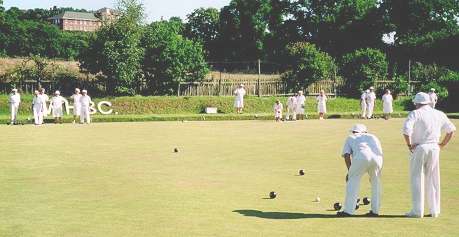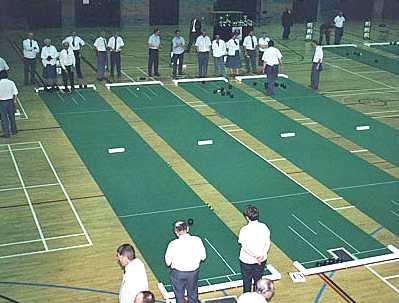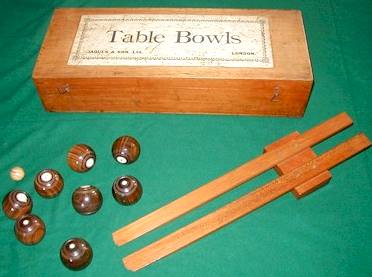|
BOWLS
|
||||||||||||||||||||||||||||||||||||||||||||||||||||||||||||||||||||||||||||||||||||||||||||||||||||||||||||||||||||
|
Bowls (also known as Lawn Bowls or Lawn Bowling) is a precision sport where the goal is to roll slightly radially asymmetrical balls (called bowls) closer to a smaller white ball (the "jack" or "kitty") than one's opponent is able to do. It is related to bocce and pétanque. This game is most popular in Australia, Canada, New Zealand, the United Kingdom, and in other UK territories.
Lawn Bowls
History
It has been traced certainly to the 13th, and conjecturally to the 12th century. William Fitzstephen (d. about 1190), in his biography of Thomas Becket, gives a graphic sketch of the London of his day and, writing of the summer amusements of the young men, says that on holidays they were "exercised in Leaping, Shooting, Wrestling, Casting of Stones [in jactu lapidum], and Throwing of Javelins fitted with Loops for the Purpose, which they strive to fling before the Mark; they also use Bucklers, like fighting Men." It is commonly supposed that by jactus lapidum Fitzstephen meant the game of bowls, but though it is possible that round stones may sometimes have been employed in an early variety of the game - and there is a record of iron bowls being used, though at a much later date, on festive occasions at Nairn, - nevertheless the inference seems unwarranted. The jactus lapidum of which he speaks was probably more akin to the modern "putting the weight," once even called "putting the stone." It is beyond dispute, however, that the game, at any rate in a rudimentary form, was played in the 13th century. A MS. of that period in the royal library, Windsor (No. 20, E iv.), contains a drawing representing two players aiming at a small cone instead of an earthenware ball or jack. Another MS. of the same century has a picture - crude, but spirited - which brings us into close touch with the existing game.
Three figures are introduced and a jack. The first player's bowl has come to rest just in front of the jack; the second has delivered his bowl and is following after it with one of those eccentric contortions still not unusual on modern greens, the first player meanwhile making a repressive gesture with his hand, as if to urge the bowl to stop short of his own; the third player is depicted as in the act of delivering his bowl. A 14th-century MS. Book of Prayers in the Francis Douce collection in the Bodleian library at Oxford contains a drawing in which two persons are shown, but they bowl to no mark. Strutt (Sports and Pastimes) suggests that the first player's bowl may have been regarded by the second player as a species of jack; but in that case it is not clear what was the first player's target. In these three earliest illustrations of the pastime it is worth noting that each player has one bowl only, and that the attitude in delivering it was as various five or six hundred years ago as it is to-day. In the third he stands almost upright; in the first he kneels; in the second he stoops, halfway between the upright and the kneeling position.
As the game grew in popularity it came under the ban of king and parliament, both fearing it might jeopardize the practice of archery, then so important in battle; and statutes forbidding it and other sports were enacted in the reigns of Edward III., Richard II. and other monarchs. Even when, on the invention of gunpowder and firearms, the bow had fallen into disuse as a weapon of war, the prohibition was continued. The discredit attaching to bowling alleys, first established in London in 1455, probably encouraged subsequent repressive legislation, for many of the alleys were connected with taverns frequented by the dissolute and gamesters. The word "bowls" occurs for the first time in the statute of 1511 in which Henry VIII. confirmed previous enactments against unlawful games. By a further act of 1541 - which was not repealed until 1845 - artificers, labourers, apprentices, servants and the like were forbidden to play bowls at any time save Christmas, and then only in their master's house and presence. It was further enjoined that any one playing bowls outside of his own garden or orchard was liable to a penalty of 6s. 8d., while those possessed of lands of the yearly value of £ioo might obtain licences to play on their own private greens.
Short Mat Bowls
Game
Bowls is usually played on a large, rectangular, precisely levelled and manicured grass or synthetic surface known as a bowling green which is divided into parallel playing strips called rinks. An indoor variation on carpet is also played. In the simplest competition, singles, one of the two opponents flips a coin to see who wins the "mat" and begins a segment of the competition (in bowling parlance, an "end"), by placing the mat and rolling the jack to the other end of the green to serve as a target. Once it has come to rest, the jack is aligned to the center of the rink and the players take turns to roll their bowls from the mat towards the jack and thereby build up the "head". A bowl is allowed to curve outside the rink boundary on its path, but must come to rest within the rink boundary to remain in play. Bowls reaching the ditch are dead and removed from play, except in the event when one has "touched" the jack on its way. "Touchers" are marked with chalk and remain alive in play even though they are in the ditch. Similarly if the jack is knocked into the ditch it is still alive unless it is out of bounds to the side resulting in a "dead" end which is replayed though according to international rules the jack is "respotted" to the center of the rink and the end is continued. After each competitor has delivered all of their bowls (four each in singles), the distance of the closest bowls to the jack is determined (the jack may have been displaced) and points, called "shots", are awarded for each bowl which a competitor has closer than the opponent's nearest to the jack. For instance, if a competitor has bowled two bowls closer to the jack than their competitor's nearest, they are awarded two shots. The exercise is then repeated for the next end, a game of bowls typically being of twenty one ends.
Scoring
Scoring systems vary from competition to competition, with some being the first to a specified number of points, say 21, or the highest scorer after say, 21 ends. Some competitions use a "set" scoring system, with the first to seven points awarded a set in a best-of-five set match. As well as singles competition, there can be pairs, triples and four-player teams. In these, teams take turns to bowl, with each player within a team bowling all their bowls, then handing over to the next player. The team captain or "skip" always plays last and is instrumental in directing his team's shots and tactics.
The current way of scoring in the professional tour is again sets. Each set consists of 7 ends (9 ends in a final), the player with the most shots at the end of a set is awarded the set, if the score is tied the set would be halfed. 2 sets are played. If the score is 1 set each then 3 tie breaker ends are played to determine a winner.
Bias of bowls
Bowls are designed to travel a curved path, referred to as bias, and was originally produced by inserting weights to one side of the bowl. This is no longer permitted by the rules and bias is now produced entirely by the shape of the bowl. A bowler can recognise the bias direction of the bowl in his hand by a dimple or symbol on one side. Regulations determine the minimum bias allowed, and the range of diameters (11.6 to 13.1 cm), but within these rules bowlers can and do choose bowls to suit their own preference. They were originally made from lignum vitae, a dense wood giving rise to the term "woods" for bowls, but are now more typically made of a hard plastic composite material. Usually coloured black, bowls are now available in a variety of colours including a range of fluorescent colours. They have unique symbol markings to identify competitors' bowls.
When bowling there are several types of delivery. "Draw" shots are those where the bowl is rolled to a specific location without causing too much disturbance of bowls already in the head. For a right-handed bowler, "forehand draw" is initially aimed to the right of the jack, and curves in to the left. The same bowler can deliver a "backhand draw" by turning the bowl over in his hand and curving it the opposite way, from left to right. In both cases, the bowl is rolled as close to the jack as possible, unless tactics demand otherwise. A "drive" involves bowling with considerable force with the aim of knocking either the jack or a specific bowl out of play - and with the drive's speed, there is virtually no noticeable curve on the shot. An "upshot" or "yard on" shot involves delivering the bowl with an extra degree of weight, enough to displace the jack or disturb other bowls in the head without killing the end. The challenge in all these shots is to be able to adjust line and length accordingly, the faster the delivery, the narrower the line or "grass".
Variations of play
Particularly in team competition there can be a large number of bowls on the green towards the conclusion of the end, and this gives rise to complex tactics. Teams "holding shot" with the closest bowl will often make their subsequent shots not with the goal of placing the bowl near the jack, but in positions to make it difficult for opponents to get their bowls into the head, or to places where the jack might be deflected to if the opponent attempts to disturb the head.
Popularity
Bowls is popular in the United Kingdom, Australia, New Zealand, Canada, and parts of the United States. Because of its relaxed pace and comparatively light physical demands, it is a popular participant sport, particularly for the elderly. However, there is a considerable professional competition dominated by younger men and women. Since the early 2000s, the sport has developed in Denmark as well.
World Indoor Singles Champions
World Outdoor Singles Champions
Sir Francis Drake
Sir Francis Drake is famous in bowls folklore: he is said to have insisted on completing his game of bowls on Plymouth Hoe before setting sail to confront the Spanish Armada in 1588.
Short Mat Bowls
Very often, there is insufficient space for several full-size bowls strips indoors. For that reason, a second popular indoor variant called Short Mat Bowls, with characteristics all of its own, has become established with a really big following all over Britain and Ireland. Like many pub games, it is really a miniaturised version of the outdoor game to enable it to be played more easily indoors while keeping as many of the features as possible. It is played on a mat measuring 40-45 x 6 feet with full-size bowls, the mat being easily rolled up and put away for convenience. There is a ditch but this is simply an area marked at the end of the mat with white fenders and to compensate for the shorter distance an intimidating block is placed in the centre of the mat. This makes it impossible for a bowler to aim a fast straight bowl at the jack area - all bowls must use the bias to curl around the block o their target.
The short mat bowls game was first played in South Wales by two South Africans who came to work in the area. They had played bowls outdoors in South Africa and, perhaps due to the poor climate and the long close season in this country, they began to play a simulation of the outdoor game on a strip of carpet in a church hall. Some time later, they moved to Northern Ireland and took the new game with them. Rules and conditions of play were drawn up and the game soon became well established in the Province. It was introduced into England by Irish expatriates, but development was slow until the 1980's when its potential as a low cost sport for people of all ages was realised. The English Short Mat Bowling Association (ESMBA) was formed in 1984, and is now the governing body of the sport in England. Thanks to the Cornwall County Short Mat Bowling Association for this information. Here is a summary of the primary differences betwen the mother game and Short Mat Bowls:
Carpet Bowls
Carpet Bowls
There is a yet a third indoor variant called Carpet Bowls which is something of the poor relative of the Bowls world and does not have the publicity it deserves, particularly in the South of England, although it is played at County and League level in East Anglia, the Midlands and the North. The term "carpet" is not helpful in this respect as many people upon hearing of the game assume it is a trivial indoor game for the home.
Carpet Bowls has seeded itself as far more of a community activity and is mainly played in local social centres such as village halls and other local community meeting places. It has in fact been the saving grace for many village halls, generating some much need revenue for the halls themselves as well as bringing local communities together. There is a formal English Carpet Bowls Association and although the ECBA is relatively small, the game itself is played in many village and school halls up and down the country. Around the turn of the century there were more than 1000 clubs. In accordance with the village hall background, the bowls mat is significantly smaller at around 30 x 6 feet and the inventors clearly laid less emphasis upon trying to maintain all the rules of the mother game. For instance, Carpet Bowls dispenses with the notion of a 'ditch' and the various sometimes complex rules associated with it. Bowls are delivered from an 18 inch wide space at the front of the carpet and must avoid an 18 inch circular block placed in the centre of the carpet. The Jack is 2.5 inches in diameter (the same as for Lawn/Indoor Bowls) and is placed on a centre line 3 - 6 feet from the end of the carpet. It does not need to be extra-heavy because, in another departure from the other lawn variants, the bowls used are smaller. Players rarely own their own set of bowls; instead the village hall usually owns the bowls for their club members' use.
Afficionados of Carpet Bowls are keen to point out that, because a bowl must be delivered within the 18 inches delivery area whilst not standing on the carpet, it is rare for players to attempt to "break up the head" (attempt to spoil the end by delivering a forceful bowl that knocks the bowls and jack semi-randomly). Carpet Bowlers regard this as a point of superiority over Short Mat Bowls where a player standing on the carpet may deliver a bowl wide of the designated delivery area with some force to spoil the head.
Table Bowls
The most unusual version of Bowls is a pub game that appeared originally around the district of Carlisle called Table Bowls. In this game a miniature set of bowls and jack are played on a standard 12 x 6 feet Billiards or Snooker table. The bowls and jack are rolled down a wooden chute which is placed slanting on the table edge with one end on the table. No impetus is allowed to be given to the bowls - it is purely the angle of the chute and how far up it the bowl starts that determines its final position.
The set above is a beautiful antique Table Bowlsmade by Jaques of London C. 1890 including green beize cloth
The
author recently heard from two players in Queensland, Australia where
there are apparently several locations playing Table Bowls - see the
Pubs section below for further details. In fact, they have a number of
competitions including a "World Championship" although they
are having second thoughts about the title having now learned of the
English game!
Rolle Bolle
Rolle Bolle was developed by Belgians, around the time of the Reformation, somewhat a cross between horseshoes and bowlings. It is played on hard packed sand, with stakes set 30 feet apart. Teams try to roll the beveled, hard rubber Bolle so that it stays closest to the stake.
Crown green bowls
Crown green bowls is a variant of lawn bowls played in the north of England, in Wales, and on the Isle of Man. It is played on a lawn from 30 to 60 yards (27 to 55 m) square. The centre of the lawn is 8 to 18 inches (200 to 450 mm) higher than its edges.
References in popular culture
LINKS and REFERENCES
This article incorporates text from the Encyclopædia Britannica Eleventh Edition, a publication now in the public domain.
World Australia British Canada England
Finland Jersey New Zealand Scotland Wales Other
PERSONAL FITNESS TRAINER, EASTBOURNE, SUSSEX
A - Z SPORTS INDEX
A taste for adventure capitalists
Solar Cola - a healthier alternative
|
||||||||||||||||||||||||||||||||||||||||||||||||||||||||||||||||||||||||||||||||||||||||||||||||||||||||||||||||||||
|
This website is Copyright © 1999 & 2020. The bird logo and name Solar Navigator are trademarks. All rights reserved. All other trademarks are hereby acknowledged. Max Energy Limited is an educational charity. |




